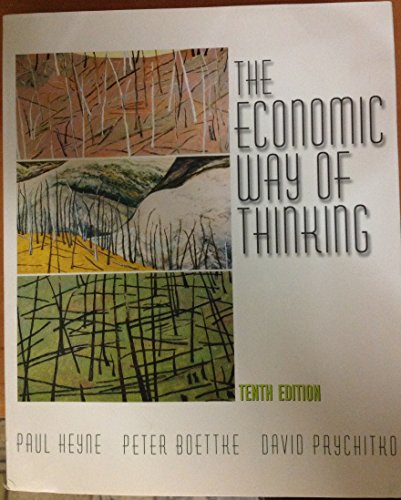Items related to The Economic Way of Thinking (10th Edition)

Synopsis
A textbook for a one-semester survey course in general economics. It introduces students to the skills of economists, and points out errors of popular reasoning about economic events. The latest edition includes more theory and application, and less formal modeling. Annotation c. Book News, Inc., Portland, OR (booknews.com)
"synopsis" may belong to another edition of this title.
From the Back Cover
The Economic Way of Thinking develops the basic principles of micro- and macroeconomic analysis, and rigorously employs them as tools rather than ends unto themselves. This book introduces readers to a method of reasoning; to think like an economist—teaching through example and application. It even teaches by showing learners how not to think, by exposing them to the errors implicit in much popular reasoning about economic events. Chapter topics include opportunity cost and the supply of goods, supply and demand, profit and loss, competition and monopoly, price searching, competition and government policy, the distribution of income, markets and government, the overall performance of economic systems, the supply of money, monetary and fiscal policies, national policies and international exchange, employment and unemployment, promoting economic growth, and the limitations of economics. For individuals seeking a deeper understanding of the effects of world events on the economy and vice versa.
"About this title" may belong to another edition of this title.
FREE shipping within U.S.A.
Destination, rates & speedsSearch results for The Economic Way of Thinking (10th Edition)
The Economic Way of Thinking (10th Edition)
Seller: Zoom Books Company, Lynden, WA, U.S.A.
Condition: very_good. Book is in very good condition and may include minimal underlining highlighting. The book can also include "From the library of" labels. May not contain miscellaneous items toys, dvds, etc. . We offer 100% money back guarantee and 24 7 customer service. Seller Inventory # ZBV.0130608106.VG
Quantity: 1 available
The Economic Way of Thinking (10th Edition)
Seller: HPB-Red, Dallas, TX, U.S.A.
paperback. Condition: Good. Connecting readers with great books since 1972! Used textbooks may not include companion materials such as access codes, etc. May have some wear or writing/highlighting. We ship orders daily and Customer Service is our top priority! Seller Inventory # S_418068798
Quantity: 1 available
The Economic Way of Thinking (10th Edition)
Seller: ThriftBooks-Dallas, Dallas, TX, U.S.A.
Paperback. Condition: Very Good. No Jacket. May have limited writing in cover pages. Pages are unmarked. ~ ThriftBooks: Read More, Spend Less 1.89. Seller Inventory # G0130608106I4N00
Quantity: 1 available
The Economic Way of Thinking (10th Edition)
Seller: ThriftBooks-Dallas, Dallas, TX, U.S.A.
Paperback. Condition: Good. No Jacket. Pages can have notes/highlighting. Spine may show signs of wear. ~ ThriftBooks: Read More, Spend Less 1.89. Seller Inventory # G0130608106I3N00
Quantity: 1 available
The Economic Way of Thinking (10th Edition)
Seller: ThriftBooks-Atlanta, AUSTELL, GA, U.S.A.
Paperback. Condition: Very Good. No Jacket. May have limited writing in cover pages. Pages are unmarked. ~ ThriftBooks: Read More, Spend Less 1.89. Seller Inventory # G0130608106I4N00
Quantity: 1 available
The Economic Way of Thinking (10th Edition)
Seller: ThriftBooks-Atlanta, AUSTELL, GA, U.S.A.
Paperback. Condition: Fair. No Jacket. Readable copy. Pages may have considerable notes/highlighting. ~ ThriftBooks: Read More, Spend Less 1.89. Seller Inventory # G0130608106I5N00
Quantity: 1 available
The Economic Way of Thinking (10th Edition)
Seller: ThriftBooks-Atlanta, AUSTELL, GA, U.S.A.
Paperback. Condition: Good. No Jacket. Pages can have notes/highlighting. Spine may show signs of wear. ~ ThriftBooks: Read More, Spend Less 1.89. Seller Inventory # G0130608106I3N00
Quantity: 1 available
The Economic Way of Thinking (10th Edition)
Seller: Starselling, Maple Grove, MN, U.S.A.
Condition: Good. Cover has normal wear and tear. Pages are very nice and clean. All books ship within 24 hours Monday - Friday. Secure bubble mailer. Fast shipping from Minnesota. Seller Inventory # 1BFWG8000A5L
Quantity: 1 available
The Economic Way of Thinking (10th Edition)
Seller: Goodwill of Greater Milwaukee and Chicago, Racine, WI, U.S.A.
Condition: acceptable. Book is considered to be in acceptable condition. The actual cover image may not match the stock photo. Book may have one or more of the following defects: noticeable wear on the cover dust jacket or spine; curved, dog eared or creased page s ; writing or highlighting inside or on the edges; sticker s or other adhesive on cover; CD DVD may not be included; and book may be a former library copy. Seller Inventory # SEWV.0130608106.A
Quantity: 1 available
The Economic Way of Thinking (10th Edition)
Seller: Toscana Books, AUSTIN, TX, U.S.A.
Paperback. Condition: new. Excellent Condition.Excels in customer satisfaction, prompt replies, and quality checks. Seller Inventory # Scanned0130608106
Quantity: 1 available

